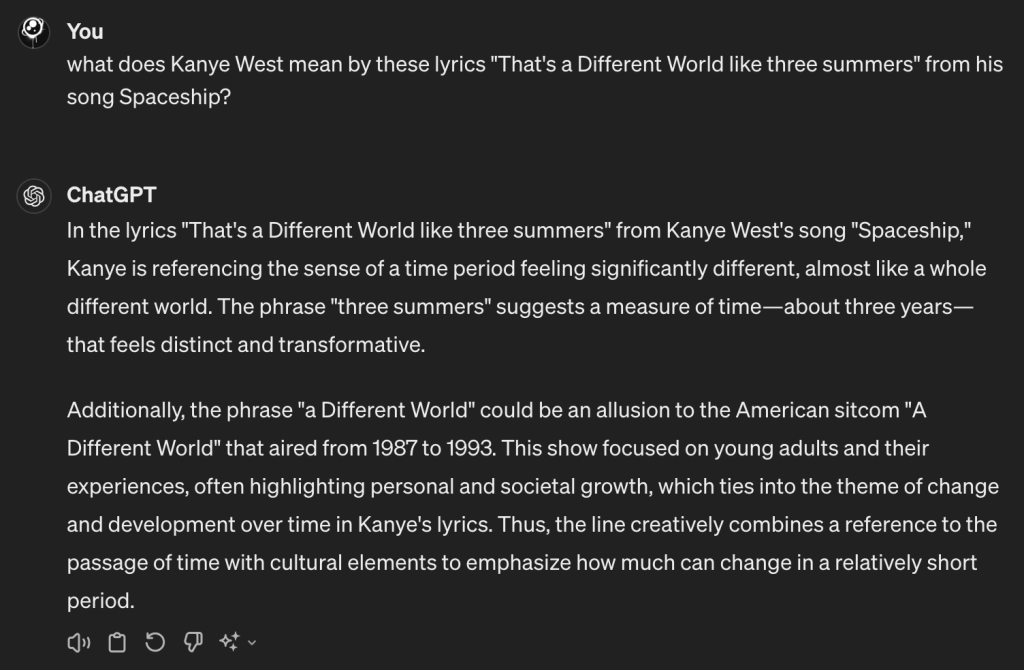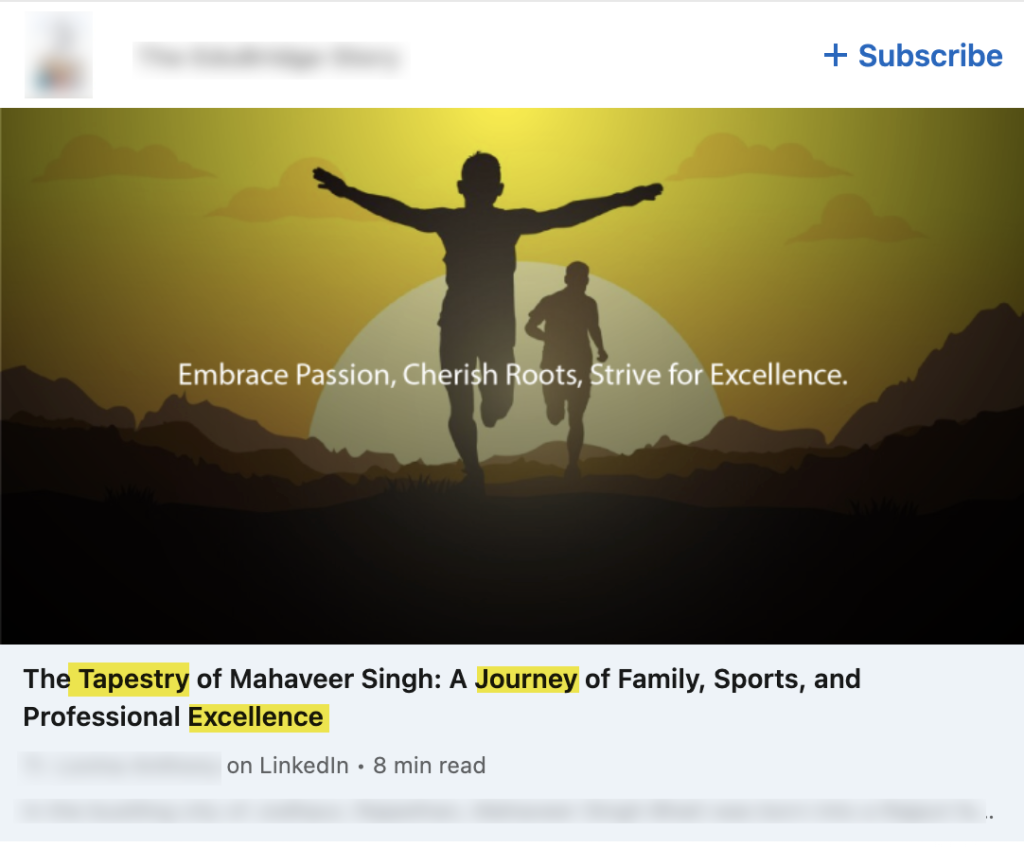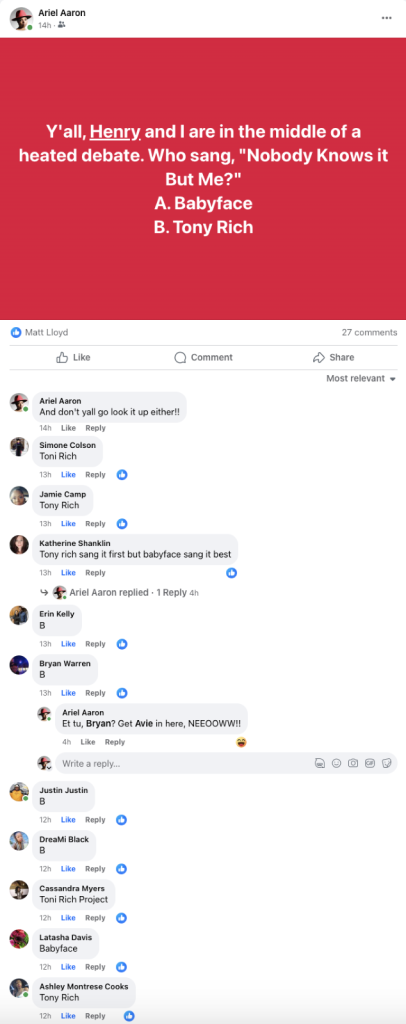Don’t AI Me to Death
Don’t AI Me to Death:
How the Overuse of AI is Killing Your Brand and Everybody Knows It
I. Introduction
This ‘gone be the realest shit I ever wrote! Prepare for a blog post with plenty of AAV (African American Vernacular, for the uninitiated), black popular and hip-hop culture references—who knows, maybe there’ll be some song lyrics up in here. Why am I so much on ten? I am doing it on purpose to make the point of this whole blog, so I hope you stick with me through my colloquiums—I promise we will arrive at a point that you absolutely need to receive.
Peruse any social media channel, blog, or heck—just check your email, and you may notice a growing trend. People seem to be using the same formatting, the same words, and the same phrasing in the content they’re putting out. It’s not a coincidence, and no, you’re not “losing your mind” in the words of Gorilla Zoe. People are increasingly putting out personal and business-related content that is obviously AI generated.
It’s true! Since ChatGPT and other AI writing tools entered the market, brands have begun using AI to scale their content operations. But some brands are using, what I call the “prompt and go” method; a strategy that involves little more than feeding AI a basic prompt, then copying and pasting its response into an output medium— lather, rinse, and repeat.
Once you see it, you can’t unsee— It’s everywhere; in cold emails, direct messages, social media posts. There are even people reading from AI generated scripts on TikTok. While I do think that AI can be useful in terms of creating efficiencies in your business, its overuse is “breaking the brands” of companies who lack understanding and strategy around its use.
Although AI is great for inspiration, structuring, and brainstorming, it lacks the human touch and authenticity that makes your brand yours. When brands use the “prompt and go” method, it’s obvious that they are relying solely on AI to write their customer-facing copy. Despite its utility, an overreliance on AI for customer-facing content can erode brand authenticity and personal touch.
According to our friends at HubSpot, small businesses don’t need to forego AI altogether. Instead, they should use AI wisely to help build upon their own creativity, “covering elements like grammar-checking, content ideation, or short-form content.” https://blog.hubspot.com/marketing/ai-generated-content
The quirks and features of communication that make us uniquely human—AI tools, as clever as they are, just can’t seem to completely grasp those nuances. By the end of this ride, I hope you’ll see the clear line I’m drawing between AI and writing with a human touch. I hope that you decide to ease off the AI bandwagon and stick to the rivers and lakes that you’re used to instead. Sometimes, the best approach is the tried and true one. For now, nothing beats letting your customers hear directly from you, the person they want to know most!
While writing this blog, I had the song “Nobody Knows it But Me” by Babyface (or was it by Tony Rich?) in mind. The lyrics to the song are about a heart-broken man who feels that he’s suffering in silence over losing his lover. Adding insult to injury, nobody even knows about his suffering, “nobody knows it but [him].” Unfortunately, that’s not the case for the AI over-indulgers; when they slap a prompt into ChatGPT and copy and paste into their socials, emails and blogs, we can all clearly tell that they phoned it in. The subject of AI makes me recall the song because while business owners might be thinking that their use of AI is undetectable, as Babyface suggests “nobody knows it but [them],” it’s obvious to the rest of the world.
The Illusion of Stealth in AI
I use “Nobody Knows it But Me” as a metaphor to illustrate how small business think that their use of AI is undetectable. I chose that song specifically because a person in my demographic, an African American woman of my age, well versed in 90’s R&B knows and still reveres the song as one of the R&B greats. It still jams, and if you don’t believe me, have a listen. My music taste, upbringing, experience and perspectives are things that make me uniquely me. I bring those things to my work, my writing and how I show up professionally and personally. While others who share the same music taste, the same goals, backgrounds, pains and joys can relate to me—and I hope that they do so I can attract my tribe here at Wild Monkey— that reasoning is what makes me uniquely me. There can only be one me. Just like there can only be one you.
According to the National Academy of Sciences, “high intelligence, cognition, and the capacity for reasoning” is what makes us uniquely human. Unfortunately, AI doesn’t completely grasp that concept, so it cannot know what it is to be human. It can only mimic humanity using language modeling to the best of its ability. AI can reference music and gestures, but cannot empathize with the feelings, emotions, and experiences that we process in our human brains. Just like I could never write like you, talk how you talk, walk how you walk, or think like you think, neither can AI. It is unique to you.
Brands do themselves a disservice when they rely on unedited AI content because the output leaves out the subtle parts that make it uniquely theirs. The things that are said without being said; the things said between the lines, are the foundations of what makes a brand great. A brand is a person’s gut feeling about a product, service, or organization. It is not what the small business owner says it is, it is what your customer says it is.
“Y’all don’t know my struggle
Y’all can’t match my hustle
You can’t catch my hustle
You can’t fathom my love dude
Lock yourself in a room doin’ five beats a day for three summers
That’s a different world like three summers
I deserve to do these numbers
The kid that made that deserves that Maybach
So many records in my basement
I’m just waitin’ on my spaceship,”
— Kanye West
In the words of the great Kaney West, “Y’all don’t know my struggle, Y’all can’t match my hustle.” He’s talking about his experience and perspectives that brought him to what turned out to be a lucrative music career. That’s his secret sauce that makes his brand unique. The strongest brands are the more profitable. The world’s most valuable brand, Apple, is calculated to be worth more than $482 billion (about $1,500 per person in the US). Brands that can strike a balance between productivity and authenticity while using AI writing tools for content creation will win big.
“I deserve to do these numbers, The kid that made that deserves that Maybach” – Kanye West
I don’t think AI is too far off, but its capabilities are not quite there yet. Just ask ChatGPT the right questions, and you can see how much AI has evolved in its ability to mimic human-like writing. I asked ChatGPT what West means by some of his lyrics, and here was its response:

While the AI can identify when our word usage references other instances of human experience, the connections to significant personal and societal conditions can be recalled only as accurately as they have already been articulated someplace online. Until we can train AI in our actual experience, it’s best to keep a human touch in the mix when generating AI content.
How Words & Phrases Sound Artificial
Certain words, phrases and sentence structures can be glaringly artificial. Although AI language models consume a large part of the information on the internet to predict the next word, producing the most human way of saying things might still pose a challenge for AI for several reasons. We don’t always write how we speak, and expressions can vary between languages and cultures.
AI has a general baseline of context on diverse topics in various languages, but it misses the mark sometimes. For example, how often do you really use the word “tapestry” if not describing fabric? If you’re speaking or writing conversationally or your brand has a less formal tone, the word “tapestry” sticks out like a sore thumb. Yet that word is used so frequently within AI generated text that it’s one of the first signs that indicates that content was written with the help of AI.

Prompting this Post
I intentionally wrote this blog with minimal use of generative AI so that our readers can observe the difference. After brainstorming a general thesis, I used two AI prompts to write this entire blog. The first prompt was to create an outline for the post, and the second was to help articulate and expand upon a statement that I made within the blog itself.
When writing and prompting for this blog, I was careful not to use words that are commonly used within AI generated content. Still, the single AI generated portion within this blog was obvious to me because it did not have the same writing style and conversational flow that exists throughout the rest of the post.
Next time you’re interacting with content, consider whether some or all of it is AI generated. Which parts of this blog appear to be AI generated or prompted? Which parts, if any, do you feel were user generated?
The AI Language Tell-tale Signs: Commonly Used Words & Phrases That Signify AI Authorship
If you’re on the fence about how much to integrate AI language models into your own content creation strategy, consider allowing space for you to interject your own personal and professional viewpoints. Even if you are merely reiterating widely known information in your industry, explain the concepts in your own words. While my rule for this blog was to fill in the AI’s outline with my own words, yours might be to brainstorm blog topics that you can make your own using AI. Whichever approach you decide to take, ensure that you put your personal touch into the content so that you don’t come off sounding robotic, out of touch and off brand.
A telltale sign that content was written by AI is the use and overuse of certain words, sentence structures and phrases. These ai-frequented words and phrases are being used in content across various industries and disciplines. If you’re using AI alone, chances are your content is riddled with these words and phrases, and so are other businesses, including your competitors. Here are a few examples of ai-frequented words and phrases that you should avoid like the plague if you don’t want to sound like everyone else.
| Word | Phrase |
| alert | Sneak Peek Alert! Exciting News Alert! |
| bounds | knows no bounds |
| delve/d/ing | Delve into the history of the region for insights. |
| donn/ed/ing | S/he donned… |
| eager | He was eager to start his new job. |
| embrace/d/ing | Embracing new challenges is essential for growth. |
| enlighten/ed/ing | The lecture was enlightening and informative. |
| esteemed | He joined the ranks of esteemed scholars. |
| excellence | Boasting over 20 years of construction excellence |
| immerse/d | Immerse yourself in… |
| journey | Embrace the journey / embarked on a journey |
| kaleidoscope | Her dress was a kaleidoscope of vibrant colors. |
| keen | I am keen to learn more… |
| path | Ignite the path… |
| pulse | Keeping a finger on the pulse of… |
| steadfast | Her steadfast dedication inspired everyone. |
| tapestry | …rich tapestry of… |
| testament | His success is a testament to his hard work. |
| unlock/ed/ing | Unlocking potential… |
| unwavering | Her unwavering support… |
| vision | …bringing your vision to life… |
| world | …in a world of.. |
| woven | …woven into the rich tapestry… |
AI also likes to use compound sentences, connecting two independent clauses with a semicolon. The two clauses are closely related and the second clause builds upon the first. The sentence structure sounds something like the phrases below:
- It was more than a duty; it was a calling
- This growth didn’t just benefit him; it strengthened his relationships.
- These accolades weren’t just symbols of success; they were reminders…
- We don’t just follow trends; we set them
Let’s look at some examples of social media content that I suspect is AI based on ai-frequented words and phrases. Like this LinkedIn Newsletter that uses some of the main AI words; tapestry (4), excellence (9) and journey (17) that show up a total of 33 times within the content.

Here is a LinkedIn post from a well-meaning patron whose short article was peppered with the use of ai-frequented words like alert, journey (8), delve and tapestry.

Or this LinkedIn article from a fellow creative service provider that uses words like weave, realm, bounds (2), and tapestry (2)

I even went to Facebook and searched the word “tapestry” and quickly realized that some of my friends— people I know personally—are using AI to write purely personal posts. I did not highlight the examples here because these are my friends. Not to embarrass anyone. We’re all friends here. But friends don’t let friends prompt drunk. You can imagine how businesses could start to sound the same.
You’ve probably noticed a few of these more widely used AI terms in the content you’ve absorbed recently. Some of them are pretty good! But whatever you think sounds good might also sound good to other content creators, including those who operate in your same industry, particularly your competitors. Imagine a prospect reading your web copy and finding that you have said exactly what competitor ABC said on their website.
<awkward!>
The Irony of Misattribution
Speaking of awkward moments, this entire blog went completely off the rails, which is kind of true to our writing style here at Wild Monkey. We intended to entitle this post something that played off the lyrics to “Nobody Knows It But Me,” a song mentioned early in this post. However, in a curious twist of events, we could not identify the true original artist to which to attribute the song. To be honest, we’re still unclear about about the origin of the song as demonstrated in this hilarious exchange with our friends on Facebook.

Unfortunatley, we could not determine whether the song was actually sung by Babyface or Tony Rich. Some folks said that Tony Rich was the song’s origonator, but Babyface sang it best. Some said that it was Tony Rich sounding like Babyface. We are quite sure that we are experiencing the Mandela effect, because we were mostly certain that this song was by Babyface.
Just like we had difficulty figuring out the song’s originator, the audience or “recipients of the AI ambush” are also unclear who is doing the talking when business owners rely soley on AI to speak for them in their client-facing content.
Much like the mix-up about the real singer of “Nobody Knows It But Me,” when we allow AI to speak for us, we all end up sounding the same. Our readers never get to meet and connect with the author of the content and the interaction falls flat. In the same way, the song snaffu, while it was fun to debate, reflects the similar confusion over the origin of AI-generated content.
Closing Thought: Speak for Yourself
At the end of the day, customers are looking to build community around the brands that they entrust with their business. Too much AI makes us all say the same things and sound alike when we say them. Sounding alike is arguably worse than looking just like other brands. Even worse, writing low-effort, low value content that is also clearly not your own work does nothing to build the trust factor.
Instead of using those AI words, think about the everyday words or phrases you would use to say the same things, communicate the same message, and evoke the same emotions. Use words that resonate with your target audience and your ideal customer.
Instead of allowing AI to speak for you, I challenge you to prompt it so that it speaks to you, allowing space for you to take inspired action to make your voice heard.
